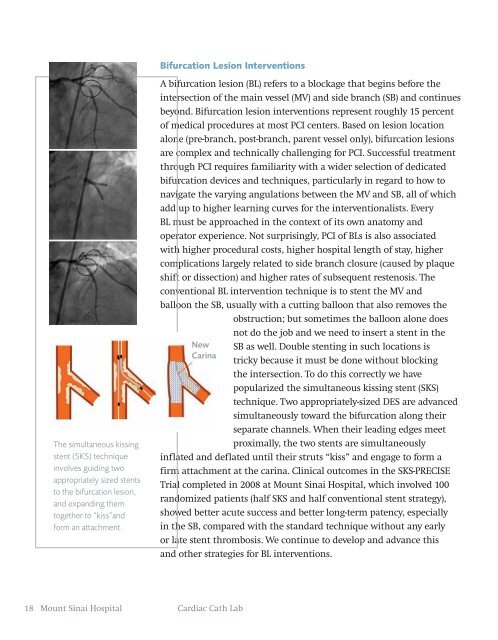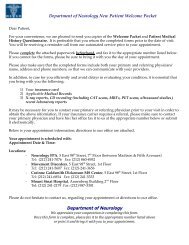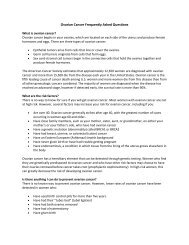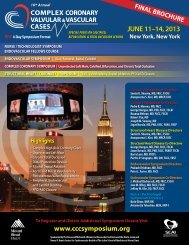CARDIAC CATH LAB - Mount Sinai Hospital
CARDIAC CATH LAB - Mount Sinai Hospital
CARDIAC CATH LAB - Mount Sinai Hospital
You also want an ePaper? Increase the reach of your titles
YUMPU automatically turns print PDFs into web optimized ePapers that Google loves.
The simultaneous kissing<br />
stent (SKS) technique<br />
involves guiding two<br />
appropriately sized stents<br />
to the bifurcation lesion,<br />
and expanding them<br />
together to “kiss”and<br />
form an attachment.<br />
Bifurcation Lesion Interventions<br />
A bifurcation lesion (BL) refers to a blockage that begins before the<br />
intersection of the main vessel (MV) and side branch (SB) and continues<br />
beyond. Bifurcation lesion interventions represent roughly 15 percent<br />
of medical procedures at most PCI centers. Based on lesion location<br />
alone (pre-branch, post-branch, parent vessel only), bifurcation lesions<br />
are complex and technically challenging for PCI. Successful treatment<br />
through PCI requires familiarity with a wider selection of dedicated<br />
bifurcation devices and techniques, particularly in regard to how to<br />
navigate the varying angulations between the MV and SB, all of which<br />
add up to higher learning curves for the interventionalists. Every<br />
BL must be approached in the context of its own anatomy and<br />
operator experience. Not surprisingly, PCI of BLs is also associated<br />
with higher procedural costs, higher hospital length of stay, higher<br />
complications largely related to side branch closure (caused by plaque<br />
shift or dissection) and higher rates of subsequent restenosis. The<br />
conventional BL intervention technique is to stent the MV and<br />
balloon the SB, usually with a cutting balloon that also removes the<br />
obstruction; but sometimes the balloon alone does<br />
New<br />
Carina<br />
not do the job and we need to insert a stent in the<br />
SB as well. Double stenting in such locations is<br />
tricky because it must be done without blocking<br />
the intersection. To do this correctly we have<br />
popularized the simultaneous kissing stent (SKS)<br />
technique. Two appropriately-sized DES are advanced<br />
simultaneously toward the bifurcation along their<br />
separate channels. When their leading edges meet<br />
proximally, the two stents are simultaneously<br />
inflated and deflated until their struts “kiss” and engage to form a<br />
firm attachment at the carina. Clinical outcomes in the SKS-PRECISE<br />
Trial completed in 2008 at <strong>Mount</strong> <strong>Sinai</strong> <strong>Hospital</strong>, which involved 100<br />
randomized patients (half SKS and half conventional stent strategy),<br />
showed better acute success and better long-term patency, especially<br />
in the SB, compared with the standard technique without any early<br />
or late stent thrombosis. We continue to develop and advance this<br />
and other strategies for BL interventions.<br />
18 <strong>Mount</strong> <strong>Sinai</strong> <strong>Hospital</strong> Cardiac Cath Lab



![December 2, 2012 [PDF] - Mount Sinai Hospital](https://img.yumpu.com/51092274/1/190x245/december-2-2012-pdf-mount-sinai-hospital.jpg?quality=85)
![January 21, 2013 [PDF] - Mount Sinai Hospital](https://img.yumpu.com/50916550/1/190x245/january-21-2013-pdf-mount-sinai-hospital.jpg?quality=85)

![February 3, 2013 [PDF] - Mount Sinai Hospital](https://img.yumpu.com/50584982/1/190x245/february-3-2013-pdf-mount-sinai-hospital.jpg?quality=85)
![March 18, 2012 [PDF] - Mount Sinai Hospital](https://img.yumpu.com/50462098/1/190x245/march-18-2012-pdf-mount-sinai-hospital.jpg?quality=85)



![Partners Program Guide [PDF] - Mount Sinai Hospital](https://img.yumpu.com/49411954/1/190x245/partners-program-guide-pdf-mount-sinai-hospital.jpg?quality=85)

![March 19 - April 1, 2012 [PDF] - Mount Sinai Hospital](https://img.yumpu.com/48990923/1/190x245/march-19-april-1-2012-pdf-mount-sinai-hospital.jpg?quality=85)
![PGY-1 Residency Application [PDF] - Mount Sinai Hospital](https://img.yumpu.com/48577701/1/190x245/pgy-1-residency-application-pdf-mount-sinai-hospital.jpg?quality=85)


